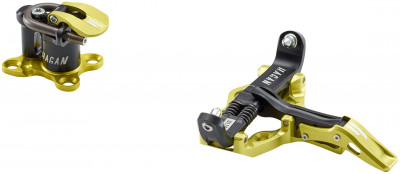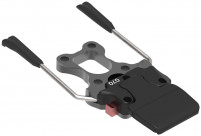When it comes to binding design, it's hard to outsmart the folks at Hagan. Never a company to avoid a challenge, Hagan tried to outsmart themselves when designing the Ultra World Cup (WC) binding, and it isn't hard to see how well they succeeded. The Ultra WC binding is an evolved form of the Hagan Ultra, with the same precisely machined toepiece with Monolink Technology (this means that there are only springs on one arm of the toepiece - this improves consistency and lowers weight by making the binding less mechanically complex). Fans of the Hagan Ultra will be pleased to see that the simple, ultralight heel hasn't changed, with one very notable exception. The Ultra WC introduces the ingenious "Rolling In System" U-spring which looks like a typical U-spring except for the rolling bushings on the end of the pins. These rollers deliver a litany of improvements, from drastically easier step in, significantly better longevity than traditional U-springs, and more consistent release over time as the steel bushings are resistant to notches that develop on titanium forks with use. Despite the increased cost of making the Rolling In System, Hagan has decided to price the Ultra WC no higher than it's forebearer, the Ultra, meaning that you get better performance and better bang for your buck.
- Rolling In System U-spring promises easier use, better consistency, and improved longevity compared to traditional U-springs.
- Monolink Technology toepiece is mechanically simpler, and therefore more effective than typical symmetrical toepieces.
- Made with ultralight aluminum and titanium forks (protected by the steel rollers) for an impressively light race binding.
- Traditional race-flap and attachment points for crampon adapters.
| Specifications | |
|
Weight |
113g |
| Weight (pair) | 226g |
|
Boot |
Tech |
|
Brakes |
None |
|
BSL |
Accessory plates |
|
Riser |
1+flat |
|
Vertical |
Fixed |
|
Lateral |
Fixed |
|
Crampon |
Removable Accessory |
| Specs Verified | Yes |
| Design | |
|
|
Aluminum Alloy, and Titanium |
| Skimo Co Says | |
| Usage | Racing, fast and light touring |
| Notes | Rolling U-Springs improve step-in, durability, and release-consistency |
| Bottom Line | Titanium-weight race binding with steel durability |
| Compare to other Race Bindings | |
Related Products
Questions & Reviews
As you might expect, these are light, simple, and just work...everything you'd want from a race binding. I was initially worried about the durability of the rolling-in pins, since they add extra moving parts. But with quite a bit of use, I haven't had any issues and they don't show signs of wear. The incremental easy of entry is only marginal, but it does seem a little easier to click in.
If flat mode is important to you, an optional adjustment plate may be worth the extra weight. There is such a tight tolerance between having enough space to clear the rear tower while the ski flexes while skinning and having the proper spacing between the boot and the U spring for proper entry/release while skiing, that a tiny amount of adjustment can make a big difference.
I don't race, but I use these on a light ski mountaineering (not skimo) ski paired with Alien RSs. It's a great combo, with the only drawback being that people expect you to move fast when they see these things!
I got the heel adjustment plate and crampon mounts, which brings the weight up a bit but they're still substantially lighter than fully featured touring bindings.
I initially pictured myself using flat mode with these, but after speaking to Mike at Hagan, he mentioned that it really only works if you mount the binding with ~1.5mm extra heel gap. If you don't do this, it'll catch on the back of your boot as your ski flexes while you skin. I decided that it wasn't worth it (I can only assume that this would affect the release characteristics) but found having only one riser height to be a non-issue with the ROM of the Alien RSs.
One thing to note is that Hagan calls the lateral release ~8 and the vertical release ~9. You can get a lighter heel spring to make the vertical release ~6, but you can't change the lateral release. This isn't a problem for me since I usually ski with a release setting around 8-9, but if you're far off from these numbers you might want to consider a different binding.
Although speaking of Torx screws, be sure to periodically check the tightness of the fastener that controls the tension of the heel flap, so that it's not too loose (else the flap might, well, flap around, and be hit by your boot heel while it's up the air).
Earn store credit by writing reviews. Learn more.














